Spatio-Temporal Trend of Past and Future Extreme Wave Climates in the Gulf of Guinea Driven by Climate Change
Abstract
:1. Introduction
2. Description of the Study Area
3. Data and Methods
3.1. Datasets
3.2. Selection of Coastal Points
3.3. Extreme Wave Climate Analysis
3.4. Trends and Changes in Extreme Wave Conditions
3.5. Statistical Tests of Significance
4. Results
4.1. Past Extreme Wave Climate and Trends
4.2. Future Change in Extreme Wave Climate
5. Discussion
5.1. Past Extreme Wave Climate and Trends
5.2. Future Change in Extreme Wave Climate
6. Conclusions
Supplementary Materials
Author Contributions
Funding
Institutional Review Board Statement
Informed Consent Statement
Data Availability Statement
Acknowledgments
Conflicts of Interest
References
- Hemer, M.A.; Trenham, C.E. Evaluation of a CMIP5 derived dynamical global wind wave climate model ensemble. Ocean Model. 2016, 103, 190–203. [Google Scholar] [CrossRef] [Green Version]
- Chowdhury, P.; Behera, M.R.; Reeve, D.E. Wave climate projections along the Indian coast. Int. J. Clim. 2019, 39, 4531–4542. [Google Scholar] [CrossRef] [Green Version]
- Döscher, R.; Acosta, M.; Alessandri, A.; Anthoni, P.; Arneth, A.; Arsouze, T.; Bergmann, T.; Bernadello, R.; Bousetta, S.; Caron, L.-P.; et al. The EC-earth3 Earth system model for the climate model intercomparison project 6. Geosci. Model Dev. Discuss. 2021, 1, 2021. [Google Scholar]
- Kulp, S.A.; Strauss, B.H. New elevation data triple estimates of global vulnerability to sea-level rise and coastal flooding. Nat. Commun. 2019, 10, 4844. [Google Scholar] [CrossRef] [Green Version]
- Sadio, M.; Anthony, E.J.; Diaw, A.T.; Dussouillez, P.; Fleury, J.T.; Kane, A.; Almar, R.; Kestenare, E. Shoreline Changes on the Wave-Influenced Senegal River Delta, West Africa: The Roles of Natural Processes and Human Interventions. Water 2017, 9, 357. [Google Scholar] [CrossRef] [Green Version]
- Mentaschi, L.; Vousdoukas, M.I.; Voukouvalas, E.; Dosio, A.; Feyen, L. Global changes of extreme coastal wave energy fluxes triggered by intensified teleconnection patterns. Geophys. Res. Lett. 2017, 44, 2416–2426. [Google Scholar] [CrossRef]
- Marcos, M.; Rohmer, J.; Vousdoukas, M.I.; Mentaschi, L.; Le Cozannet, G.; Amores, A. Increased Extreme Coastal Water Levels Due to the Combined Action of Storm Surges and Wind Waves. Geophys. Res. Lett. 2019, 46, 4356–4364. [Google Scholar] [CrossRef] [Green Version]
- Dada, O.A.; Almar, R.; Oladapo, M.I. Recent coastal sea-level variations and flooding events in the Nigerian Transgressive Mud coast of Gulf of Guinea. J. Afr. Earth Sci. 2019, 161, 103668. [Google Scholar] [CrossRef]
- Dada, O.A.; Li, G.; Qiao, L.; Ma, Y.; Ding, D.; Xu, J.; Li, P.; Yang, J. Response of wave and coastline evolution to global climate change off the Niger Delta during the past 110 years. Mar. Syst. 2016, 160, 64–80. [Google Scholar] [CrossRef]
- Anthony, E.; Almar, R.; Aagaard, T. Recent shoreline changes in the Volta River delta, West Africa: The roles of natural processes and human impacts. Afr. J. Aquat. Sci. 2016, 41, 81–87. [Google Scholar] [CrossRef]
- Ondoa, G.A.; Bonou, F.; Tomety, F.S.; Du Penhoat, Y.; Perret, C.; Degbe, C.G.E.; Almar, R. Beach Response to Wave Forcing from Event to Inter-Annual Time Scales at Grand Popo, Benin (Gulf of Guinea). Water 2017, 9, 447. [Google Scholar] [CrossRef]
- Morim, J.; Hemer, M.; Cartwright, N.; Strauss, D.; Andutta, F. On the concordance of 21st century wind-wave climate projections. Glob. Planet. Chang. 2018, 167, 160–171. [Google Scholar] [CrossRef]
- Guo, G.; Wang, Y.; Gan, J.; Wu, W.; Ye, Y. Study on wave load prediction and fatigue damage analysis of river-sea-going ship. In Proceedings of the International Conference on Offshore Mechanics and Arctic Engineering, Madrid, Spain, 17–22 June 2018; American Society of Mechanical Engineers: New York, NY, USA, 2018; Volume 51326, p. V11AT12A016. [Google Scholar]
- Kamphuis, J.W. Introduction to Coastal Engineering and management; World Scientific: Singapore, 2020; Volume 48. [Google Scholar]
- McInnes, K.L.; White, C.J.; Haigh, I.D.; Hemer, M.A.; Hoeke, R.K.; Holbrook, N.J.; Kiem, A.S.; Oliver, E.C.J.; Ranasinghe, R.; Walsh, K.J.E.; et al. Natural hazards in Australia: Sea level and coastal extremes. Clim. Chang. 2016, 139, 69–83. [Google Scholar] [CrossRef] [Green Version]
- Shao, M.; Han, Z.; Sun, J.; Xiao, C.; Zhang, S.; Zhao, Y. A review of multi-criteria decision making applications for renewable energy site selection. Renew. Energy 2020, 157, 377–403. [Google Scholar] [CrossRef]
- Smith, G.; Yesilnacar, E.; Jiang, J.; Taylor, C. Marine Habitat Mapping Incorporating Both Derivatives of LiDAR Data and Hydrodynamic Conditions. J. Mar. Sci. Eng. 2015, 3, 492–508. [Google Scholar] [CrossRef] [Green Version]
- Ferreira, A.; Garrido-Amador, P.; Brito, A.C. Disentangling Environmental Drivers of Phytoplankton Biomass off Western Iberia. Front. Mar. Sci. 2019, 6, 1128. [Google Scholar] [CrossRef] [Green Version]
- Nieto, K.; Mélin, F. Variability of chlorophyll-a concentration in the Gulf of Guinea and its relation to physical oceanographic variables. Prog. Oceanogr. 2016, 151, 97–115. [Google Scholar] [CrossRef]
- Abe, J.; Brown, B.E. Towards a Guinea Current Large Marine Ecosystem Commission. Environ. Dev. 2020, 36, 100590. [Google Scholar] [CrossRef]
- Alves, B.; Angnuureng, D.B.; Morand, P.; Almar, R. A review on coastal erosion and flooding risks and best management practices in West Africa: What has been done and should be done. J. Coast. Conserv. 2020, 24, 1725–1737. [Google Scholar] [CrossRef]
- Osinowo, A.; Okogbue, E.; Eresanya, E.; Akande, O. Extreme significant wave height climate in the Gulf of Guinea. Afr. J. Mar. Sci. 2018, 40, 407–421. [Google Scholar] [CrossRef]
- Croitoru, L.; Miranda, J.J.; Sarraf, M. The Cost of Coastal Zone Degradation in West Africa: Benin, Cote d’Ivoire, Senegal and Togo; World Bank: Washington, DC, USA, 2019. [Google Scholar]
- Grigorieva, V.G.; Badulin, S.I.; Gulev, S.K. Global Validation of SWIM/CFOSAT Wind Waves Against Voluntary Observing Ship Data. Earth Space Sci. 2022, 9, e2021EA002008. [Google Scholar] [CrossRef]
- Vettor, R.; Guedes Soares, C. On the Accuracy of Voluntary Observing Ship’s Records. J. Offshore Mech. Arct. Eng. 2021, 143, 054501. [Google Scholar] [CrossRef]
- Vettor, R.; Guedes Soares, C. Comparison of VOS and ERA-Interim Wave Data. In Proceedings of the International Conference on Offshore Mechanics and Arctic Engineering, Glasgow, UK, 9–14 June 2019; American Society of Mechanical Engineers: New York, NY, USA, 2019; Volume 3, p. V003T02A045. [Google Scholar] [CrossRef]
- Meucci, A.; Young, I.R.; Breivik, Ø. Wind and Wave Extremes from Atmosphere and Wave Model Ensembles. J. Clim. 2018, 31, 8819–8842. [Google Scholar] [CrossRef]
- Takbash, A.; Young, I.R. Long-Term and Seasonal Trends in Global Wave Height Extremes Derived from ERA-5 Reanalysis Data. J. Mar. Sci. Eng. 2020, 8, 1015. [Google Scholar] [CrossRef]
- Morim, J.; Erikson, L.H.; Hemer, M.; Young, I.; Wang, X.; Mori, N.; Shimura, T.; Stopa, J.; Trenham, C.; Mentaschi, L.; et al. A global ensemble of ocean wave climate statistics from contemporary wave reanalysis and hindcasts. Sci. Data 2022, 9, 1–8. [Google Scholar] [CrossRef]
- Ribal, A.; Young, I.R. 33 years of globally calibrated wave height and wind speed data based on altimeter observations. Sci. Data 2019, 6, 77. [Google Scholar] [CrossRef] [Green Version]
- Vanem, E. Uncertainties in extreme value modelling of wave data in a climate change perspective. J. Ocean Eng. Mar. Energy 2015, 1, 339–359. [Google Scholar] [CrossRef] [Green Version]
- Aarnes, O.J.; Reistad, M.; Breivik, Ø.; Bitner-Gregersen, E.; Ingolf Eide, L.; Gramstad, O.; Magnusson, A.K.; Bent Natvig, B. Projected changes in significant wave height toward the end of the 21st century: Northeast A tlantic. J. Geophys. Res. Ocean. 2017, 122, 3394–3403. [Google Scholar] [CrossRef] [Green Version]
- Perez, J.; Menendez, M.; Mendez, F.; Losada, I.J. Evaluating the performance of CMIP3 and CMIP5 global climate models over the north-east Atlantic region. Clim. Dyn. 2014, 43, 2663–2680. [Google Scholar] [CrossRef]
- Casas-Prat, M.; Sierra, J.P. Projected future wave climate in the NW Mediterranean Sea. J. Geophys. Res. Ocean. 2013, 118, 3548–3568. [Google Scholar] [CrossRef]
- Li, J.; Chen, Y.; Pan, S.; Pan, Y.; Fang, J.; Sowa, D.M. Estimation of mean and extreme waves in the East China Seas. Appl. Ocean Res. 2016, 56, 35–47. [Google Scholar] [CrossRef]
- Osinowo, A.A.; Popoola, S.O. Long-term spatio-temporal trends in extreme wave events in the Niger delta coastlines. Cont. Shelf Res. 2021, 224, 104471. [Google Scholar] [CrossRef]
- Toualy, E.; Aman, A.; Koffi, P.; Marin, F.; Wango, T. Ocean swell variability along the northern coast of the Gulf of Guinea. Afr. J. Mar. Sci. 2015, 37, 353–361. [Google Scholar] [CrossRef]
- Hemer, M.A.; Wang, X.L.; Weisse, R.; Swail, V.R. Advancing wind-waves climate science: The COWCLIP project. Bull. Am. Meteorol. Soc. 2012, 93, 791–796. [Google Scholar] [CrossRef]
- Morim, J.; Trenham, C.; Hemer, M.; Wang, X.L.; Mori, N.; Casas-Prat, M.; Semedo, A.; Shimura, T.; Ben Timmermans, B.; Camus, P.; et al. A global ensemble of ocean wave climate projections from CMIP5-driven models. Sci. Data 2020, 7, 1–10. [Google Scholar] [CrossRef] [Green Version]
- Semedo, A.; Weisse, R.; Behrens, A.; Sterl, A.; Bengtsson, L.; Günther, H. Projection of Global Wave Climate Change toward the End of the Twenty-First Century. J. Clim. 2012, 26, 8269–8288. [Google Scholar] [CrossRef] [Green Version]
- Angnuureng, D.B.; Almar, R.; Senechal, N.; Castelle, B.; Addo, K.A.; Marieu, V.; Ranasinghe, R. Shoreline resilience to individual storms and storm clusters on a meso-macrotidal barred beach. Geomorphology 2017, 290, 265–276. [Google Scholar] [CrossRef]
- Dada, O.A.; Agbaje, A.O.; Adesina, R.B.; Asiwaju-Bello, Y.A. Effect of coastal land use change on coastline dynamics along the Nigerian Transgressive Mahin mud coast. Ocean Coast. Manag. 2018, 168, 251–264. [Google Scholar] [CrossRef]
- Abessolo, G.O.; Hoan, L.X.; Larson, M.; Almar, R. Modeling the Bight of Benin (Gulf of Guinea, West Africa) coastline response to natural and anthropogenic forcing. Reg. Stud. Mar. Sci. 2021, 48, 101995. [Google Scholar] [CrossRef]
- Miller, M.J.; Robinet, T. Life history and morphology of Eel Larvae in the Gulf of Guinea of western Africa: Revisiting Jacques Blache’s research (1960–1977) 40 years later. Rev. Fish Biol. Fish. 2018, 28, 355–379. [Google Scholar] [CrossRef]
- Almar, R.; Kestenare, E.; Reyns, J.; Jouanno, J.; Anthony, E.; Laibi, R.; Hemer, M.; Du Penhoat, Y.; Ranasinghe, R. Response of the Bight of Benin (Gulf of Guinea, West Africa) coastline to anthropogenic and natural forcing, Part1: Wave climate variability and impacts on the longshore sediment transport. Cont. Shelf Res. 2015, 110, 48–59. [Google Scholar] [CrossRef]
- Giardino, A.; Schrijvershof, R.; Nederhoff, C.; De Vroeg, H.; Brière, C.; Tonnon, P.-K.; Caires, S.; Walstra, D.; Sosa, J.; Van Verseveld, W.; et al. A quantitative assessment of human interventions and climate change on the West African sediment budget. Ocean Coast. Manag. 2018, 156, 249–265. [Google Scholar] [CrossRef]
- Laïbi, R.A.; Anthony, E.J.; Almar, R.; Castelle, B.; Senechal, N.; Kestenare, E. Longshore drift cell development on the human-impacted Bight of Benin sand barrier coast, West Africa. J. Coast. Res. 2014, 70, 78–83. [Google Scholar] [CrossRef]
- Hemer, M.; Trenham, C.; Durrant, T.; Greenslade, D. CAWCR Global wind-wave 21st century climate projections. Commonw. Sci. Ind. Res. Organ. Canberra Aust. 2015. [Google Scholar] [CrossRef]
- Lobeto, H.; Menendez, M.; Losada, I.J. Future behavior of wind wave extremes due to climate change. Sci. Rep. 2021, 11, 1–12. [Google Scholar] [CrossRef]
- Young, I.R.; Vinoth, J.; Zieger, S.; Babanin, A. Investigation of trends in extreme value wave height and wind speed. J. Geophys. Res. Earth Surf. 2012, 117. [Google Scholar] [CrossRef]
- Change, I.C. The physical science basis. In Contribution of Working Group I to the Fifth Assessment Report of the Intergovernmental Panel on Climate Change; IPCC: Geneva, Switzerland, 2013; Volume 1535, p. 2013. [Google Scholar]
- Bergsma, E.W.; Almar, R.; Anthony, E.J.; Garlan, T.; Kestenare, E. Wave variability along the world’s continental shelves and coasts: Monitoring opportunities from satellite Earth observation. Adv. Space Res. 2022, 69, 3236–3244. [Google Scholar] [CrossRef]
- Greene, C.A.; Thirumalai, K.; Kearney, K.A.; Delgado, J.M.; Schwanghart, W.; Wolfenbarger, N.S.; Thyng, K.M.; Gwyther, D.E.; Gardner, A.S.; Blankenship, D.D. The Climate Data Toolbox for MATLAB. Geochem. Geophys. Geosystems 2019, 20, 3774–3781. [Google Scholar] [CrossRef] [Green Version]
- Aydoğan, B.; Ayat, B. Spatial variability of long-term trends of significant wave heights in the Black Sea. Appl. Ocean Res. 2018, 79, 20–35. [Google Scholar] [CrossRef]
- Caloiero, T.; Aristodemo, F.; Ferraro, D.A. Trend analysis of significant wave height and energy period in southern Italy. Arch. Meteorol. Geophys. Bioclimatol. Ser. B 2019, 138, 917–930. [Google Scholar] [CrossRef]
- Wang, J.; Liu, J.; Wang, Y.; Liao, Z.; Sun, P. Spatiotemporal variations and extreme value analysis of significant wave height in the South China Sea based on 71-year long ERA5 wave reanalysis. Appl. Ocean Res. 2021, 113, 102750. [Google Scholar] [CrossRef]
- Anthony, E.; Almar, R.; Besset, M.; Reyns, J.; Laibi, R.; Ranasinghe, R.; Ondoa, G.A.; Vacchi, M. Response of the Bight of Benin (Gulf of Guinea, West Africa) coastline to anthropogenic and natural forcing, Part 2: Sources and patterns of sediment supply, sediment cells, and recent shoreline change. Cont. Shelf Res. 2018, 173, 93–103. [Google Scholar] [CrossRef]
- Osinowo, A.A.; Balogun, I.A.; Eresanya, E.O. Assessment of wave energy resource in the mid-Atlantic based on 37-year numerical hindcast data. Model. Earth Syst. Environ. 2018, 4, 935–959. [Google Scholar] [CrossRef]
- Xorse, T.M. Impact of Wave Dynamics on the Coast of Ghana. Ph.D. Thesis, University of Ghana, Accra, Ghana, 2013. [Google Scholar]
- Roest, L.W.M. The Coastal System of the Volta Delta, Ghana. Master’s Thesis, Delft University of Technology, Delft, The Netherlands, 2018. [Google Scholar]
- Bolle, A.; Das Neves, L.; Rooseleer, J. Coastal protection for Ada, Ghana: A case study. Proc. Inst. Civ. Eng. Marit. Eng. 2015, 168, 125–133. [Google Scholar] [CrossRef]
- Ondoa, G.A.; Onguéné, R.; Eyango, M.T.; Duhaut, T.; Mama, C.; Angnuureng, D.B.; Almar, R. Assessment of the Evolution of Cameroon Coastline: An Overview from 1986 to 2015. J. Coast. Res. 2018, 81, 122–129. [Google Scholar] [CrossRef]
- Kengap, A.K.; Kamga, F.T.; Kwetche, P.F.; Ngueguim, J.R.; Atem, W.E.; Essome, L.M.; Ntangyong, I.L. Impact of hydrodynamic forcings on the morphodynamics of Idenau beach, Western Cameroon coast. J. Mater. Environ. Sci. 2020, 11, 486–498. [Google Scholar]
- Angnuureng, D.; Brempong, K.; Jayson-Quashigah, P.; Dada, O.; Akuoko, S.; Frimpomaa, J.; Mattah, P.; Almar, R. Satellite, drone and video camera multi-platform monitoring of coastal erosion at an engineered pocket beach: A showcase for coastal management at Elmina Bay, Ghana (West Africa). Reg. Stud. Mar. Sci. 2022, 53, 102437. [Google Scholar] [CrossRef]
- Wang, X.L.; Swail, V.R. Changes of Extreme Wave Heights in Northern Hemisphere Oceans and Related Atmospheric Circulation Regimes. J. Clim. 2001, 14, 2204–2221. [Google Scholar] [CrossRef]
- Wang, X.L.; Swail, V.R. Trends of Atlantic Wave Extremes as Simulated in a 40-Yr Wave Hindcast Using Kinematically Reanalyzed Wind Fields. J. Clim. 2002, 15, 1020–1035. [Google Scholar] [CrossRef]
- Caires, S.; Sterl, A. 100-Year Return Value Estimates for Ocean Wind Speed and Significant Wave Height from the ERA-40 Data. J. Clim. 2005, 18, 1032–1048. [Google Scholar] [CrossRef]
- Bricheno, L.M.; Wolf, J. Future wave conditions of Europe, in response to high-end climate change scenarios. J. Geophys. Res. Ocean. 2018, 123, 8762–8791. [Google Scholar] [CrossRef] [Green Version]
- Wiggins, M.; Scott, T.; Masselink, G.; Russell, P.; Valiente, N.G. Regionally-Coherent Embayment Rotation: Behavioural Response to Bi-Directional Waves and Atmospheric Forcing. J. Mar. Sci. Eng. 2019, 7, 116. [Google Scholar] [CrossRef] [Green Version]
- Hemer, M.; Fan, Y.; Mori, N.; Semedo, Á.; Wang, X.L. Projected changes in wave climate from a multi-model ensemble. Nat. Clim. Chang. 2013, 3, 471–476. [Google Scholar] [CrossRef]
- AIT, S.T.; Weesakul, S.; Dastgheib, A.; Ranasinghe, R. Climate Change Driven Variations in Future Longshore Sediment Transport Rates along the Coast of Vietnam; Institute of Water Education: Delft, The Netherlands, 2014. [Google Scholar]
- Almar, R.; Kestenare, E.; Boucharel, J. On the key influence of remote climate variability from Tropical Cyclones, North and South Atlantic mid-latitude storms on the Senegalese coast (West Africa). Environ. Res. Commun. 2019, 1, 071001. [Google Scholar] [CrossRef] [Green Version]
- Yin, J.H. A consistent poleward shift of the storm tracks in simulations of 21st century climate. Geophys. Res. Lett. 2005, 32, L18701. [Google Scholar] [CrossRef] [Green Version]
- Chang, E.K.M.; Guo, Y.; Xia, X. CMIP5 multimodel ensemble projection of storm track change under global warming. J. Geophys. Res. Earth Surf. 2012, 117, D23. [Google Scholar] [CrossRef]
- Young, I.R.; Zieger, S.; Babanin, A.V. Global Trends in Wind Speed and Wave Height. Science 2011, 332, 451–455. [Google Scholar] [CrossRef]
- Gonazález, F.I. A Case Study of Wave–Current–Bathymetry Interactions at the Columbia River Entrance. J. Phys. Oceanogr. 1984, 14, 1065–1078. [Google Scholar] [CrossRef]
- Herterich, J.G.; Dias, F. Extreme long waves over a varying bathymetry. J. Fluid Mech. 2019, 878, 481–501. [Google Scholar] [CrossRef]
- Herterich, J.G.; Dias, F. Wave breaking and runup of long waves approaching a cliff over a variable bathymetry. Procedia IUTAM 2017, 25, 18–27. [Google Scholar] [CrossRef]

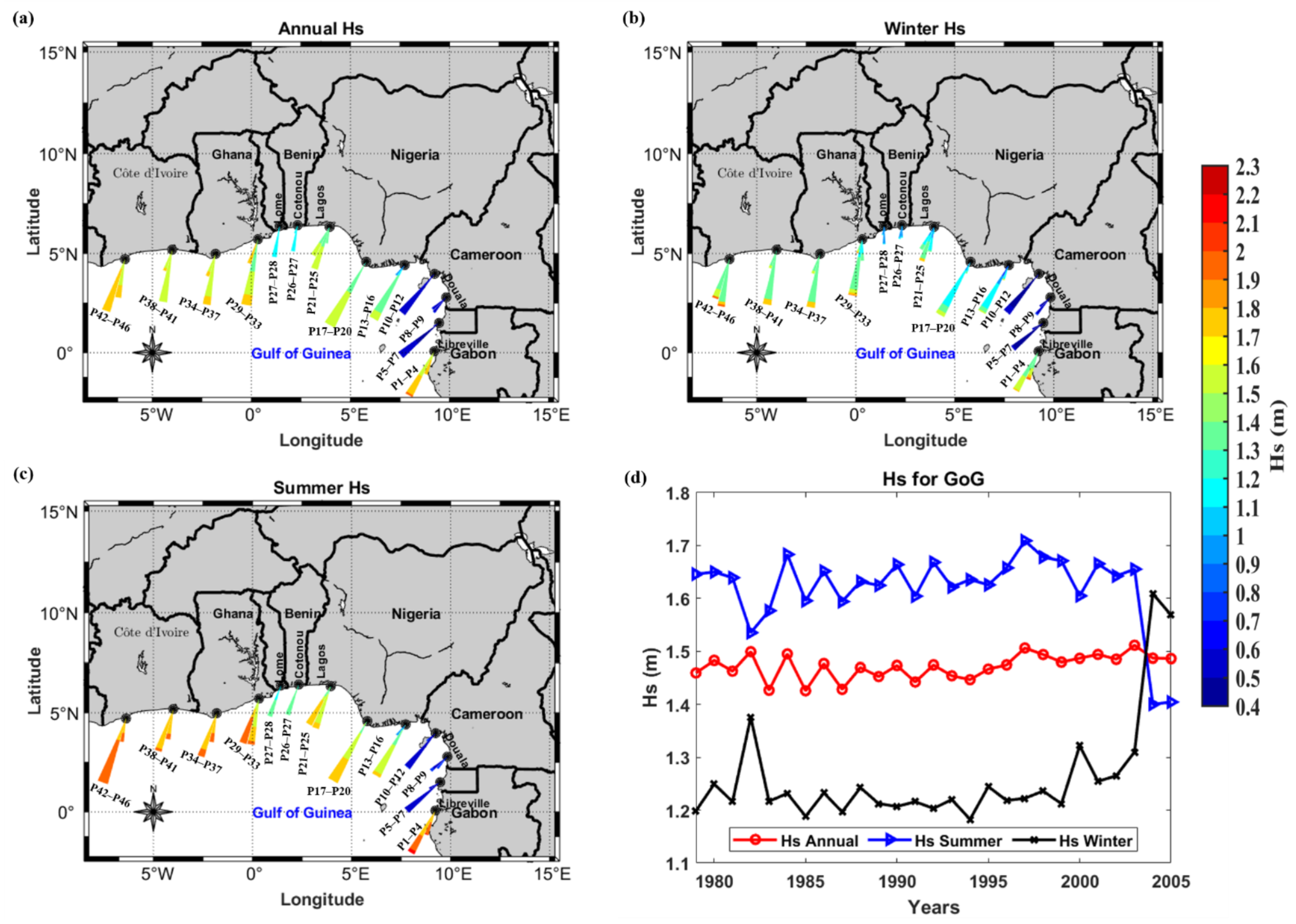
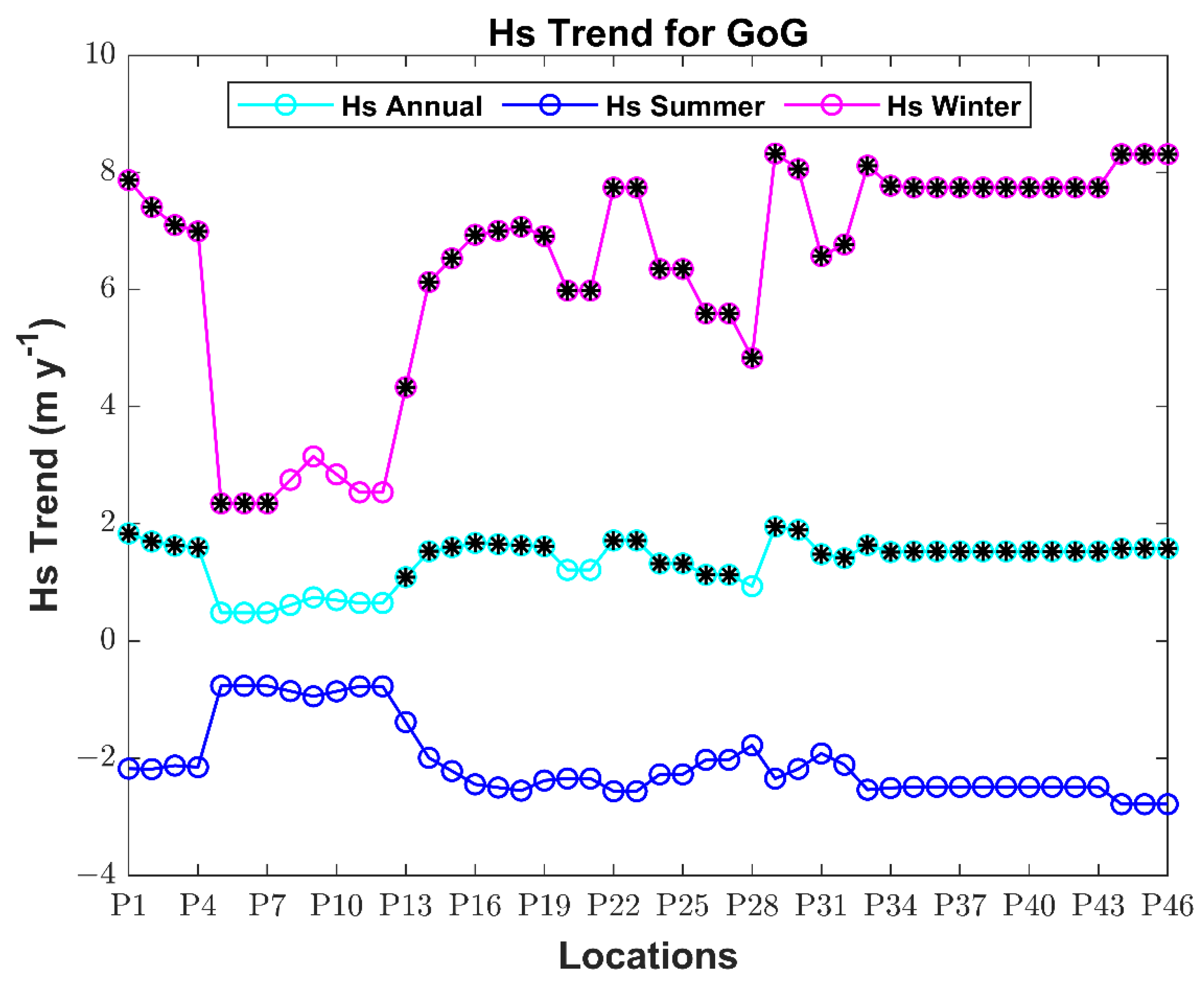
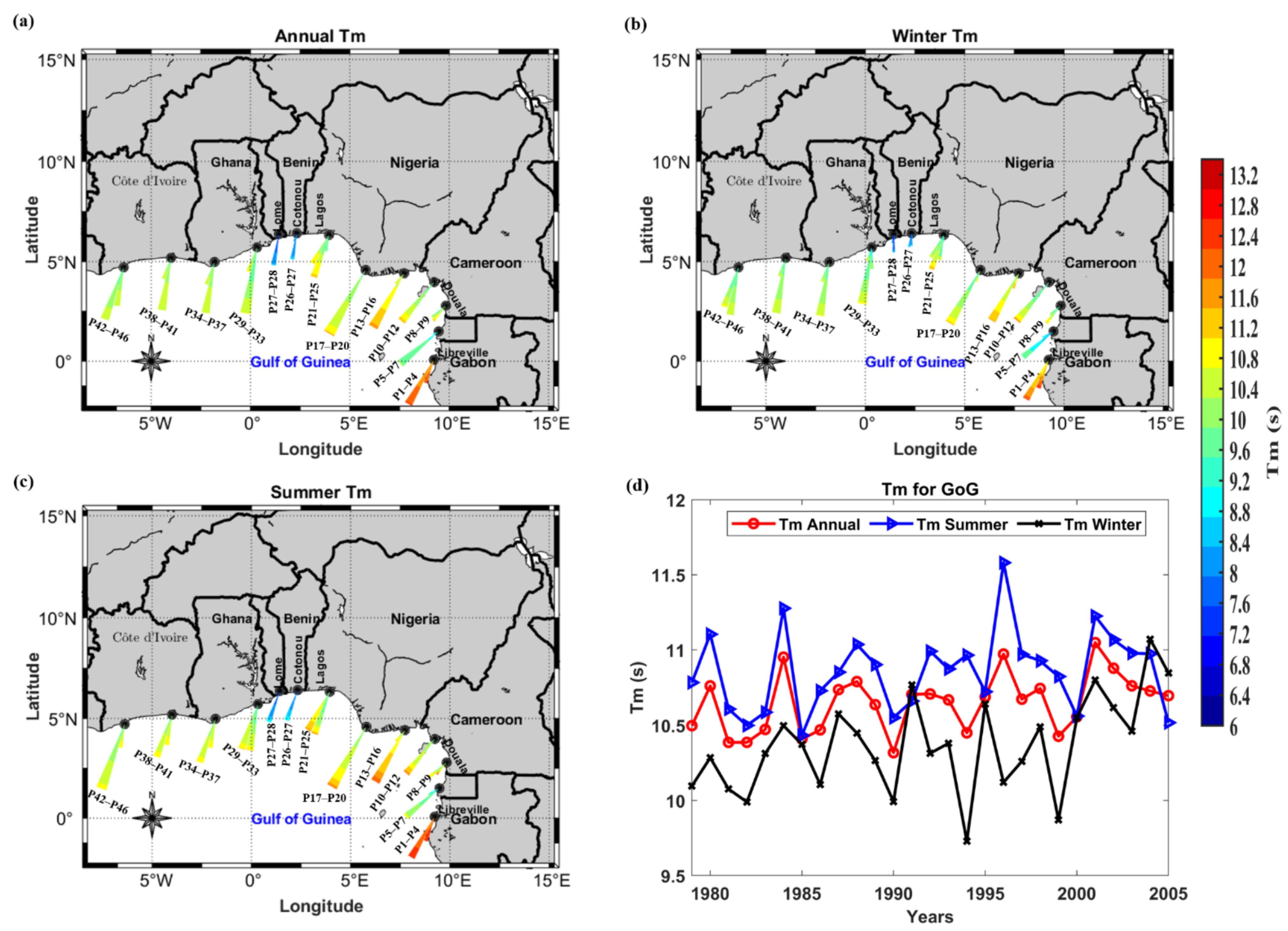

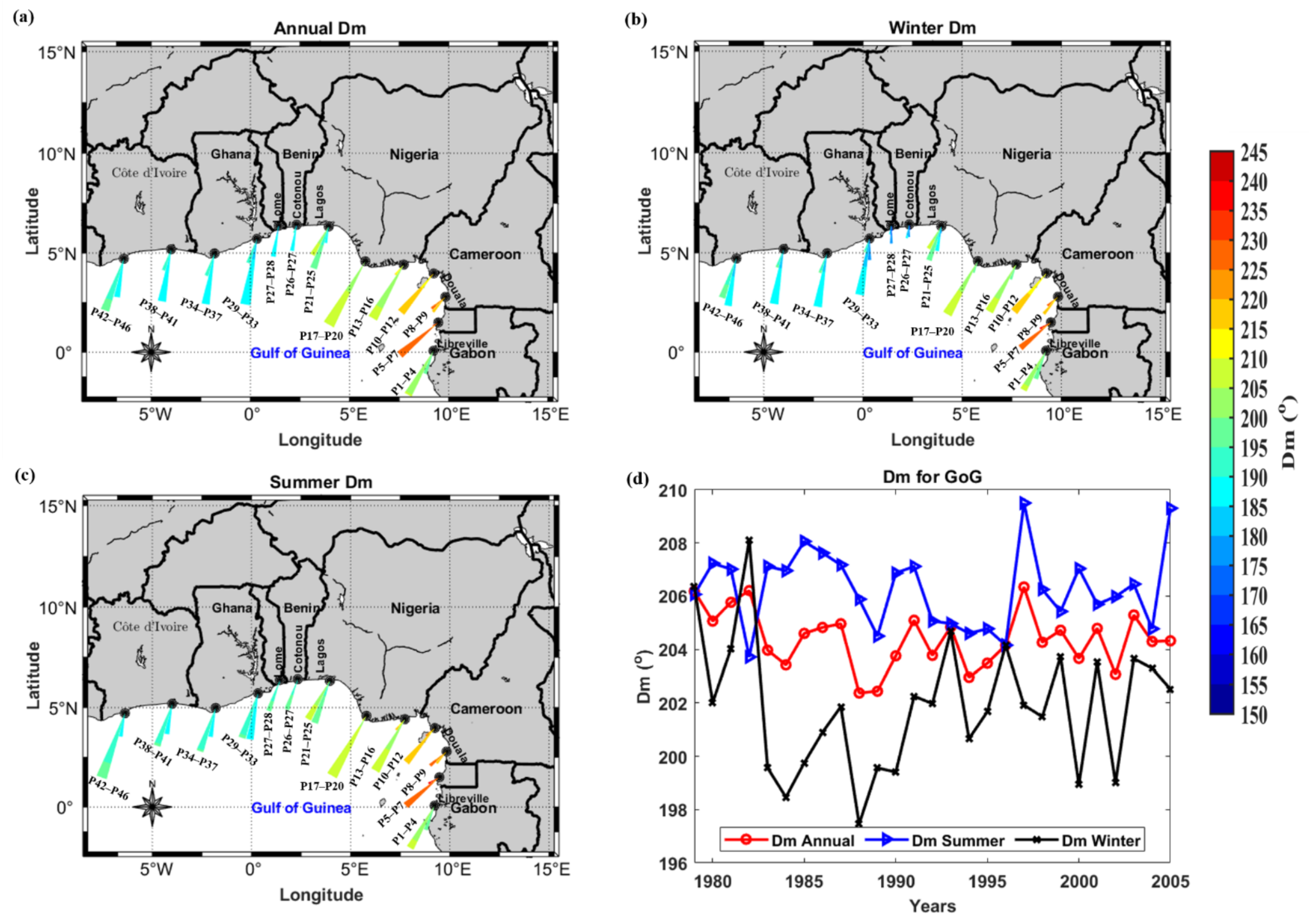
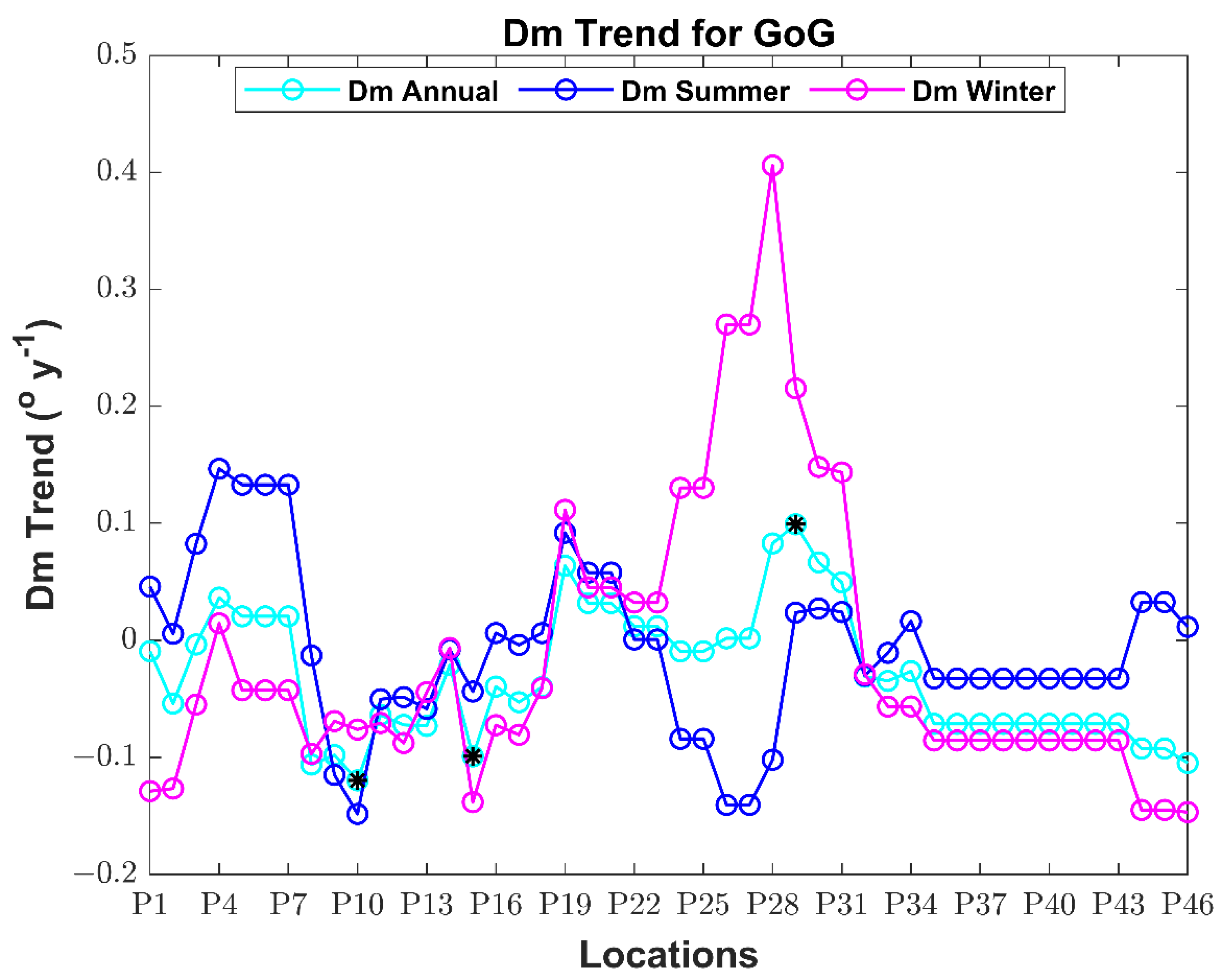
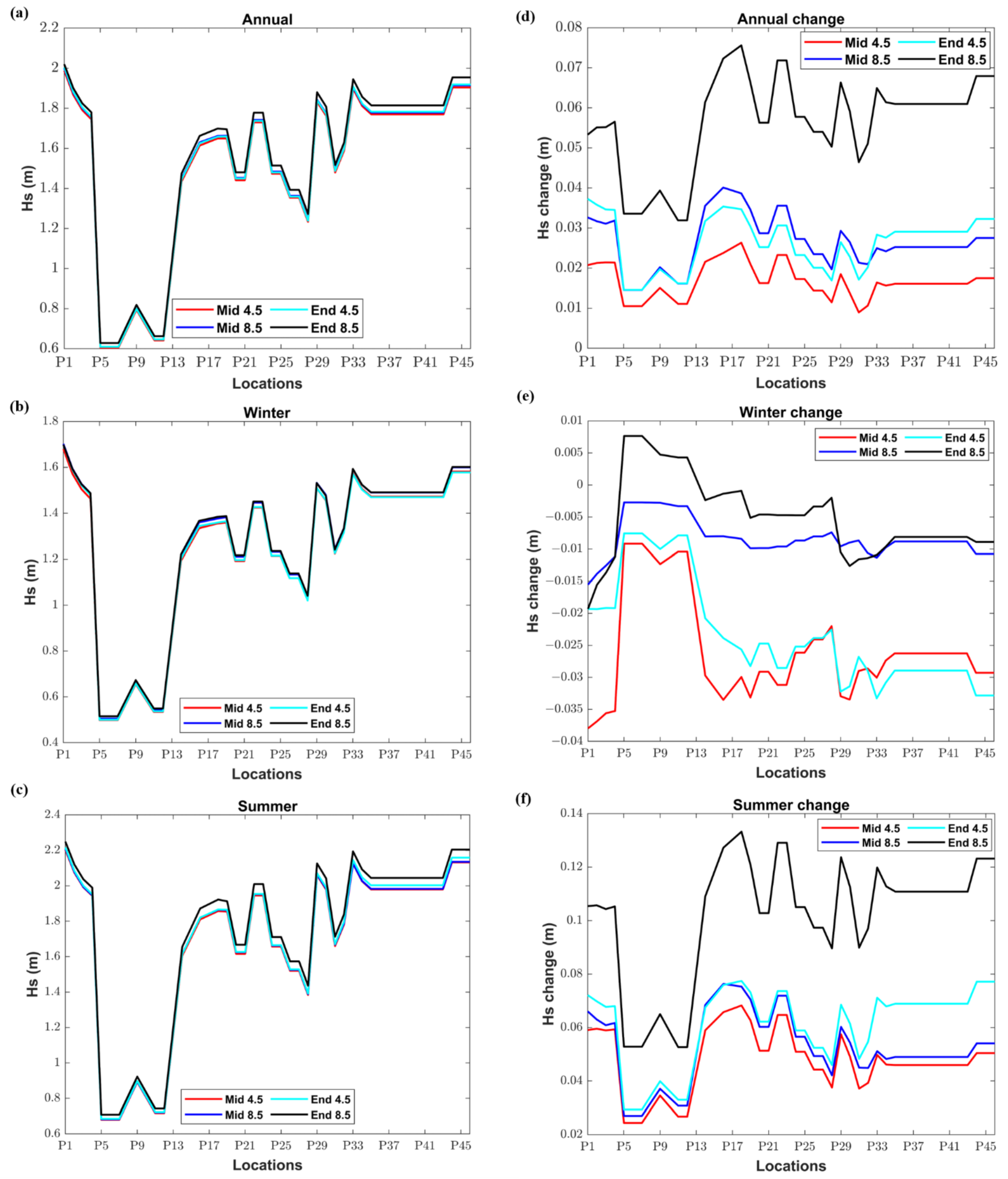
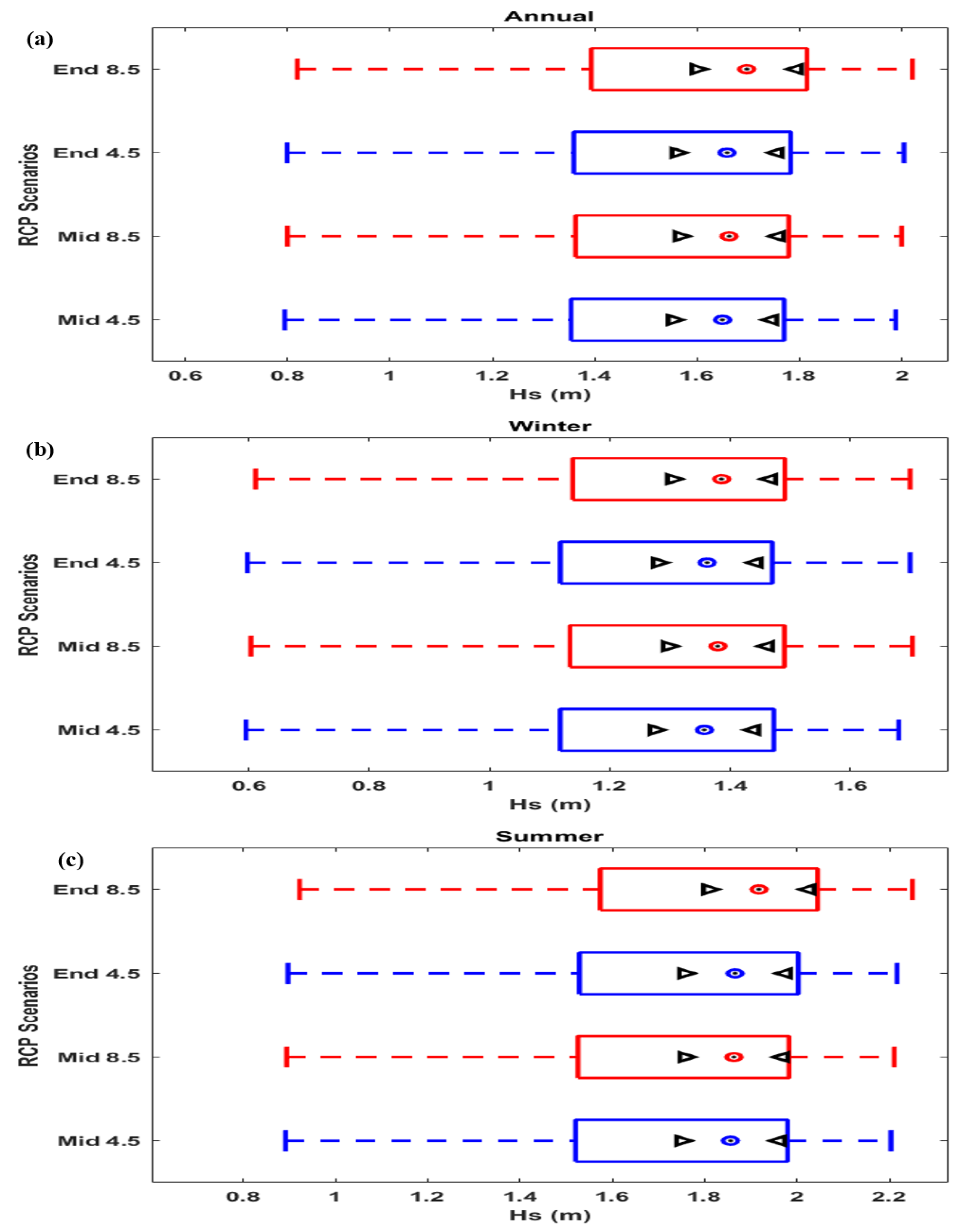
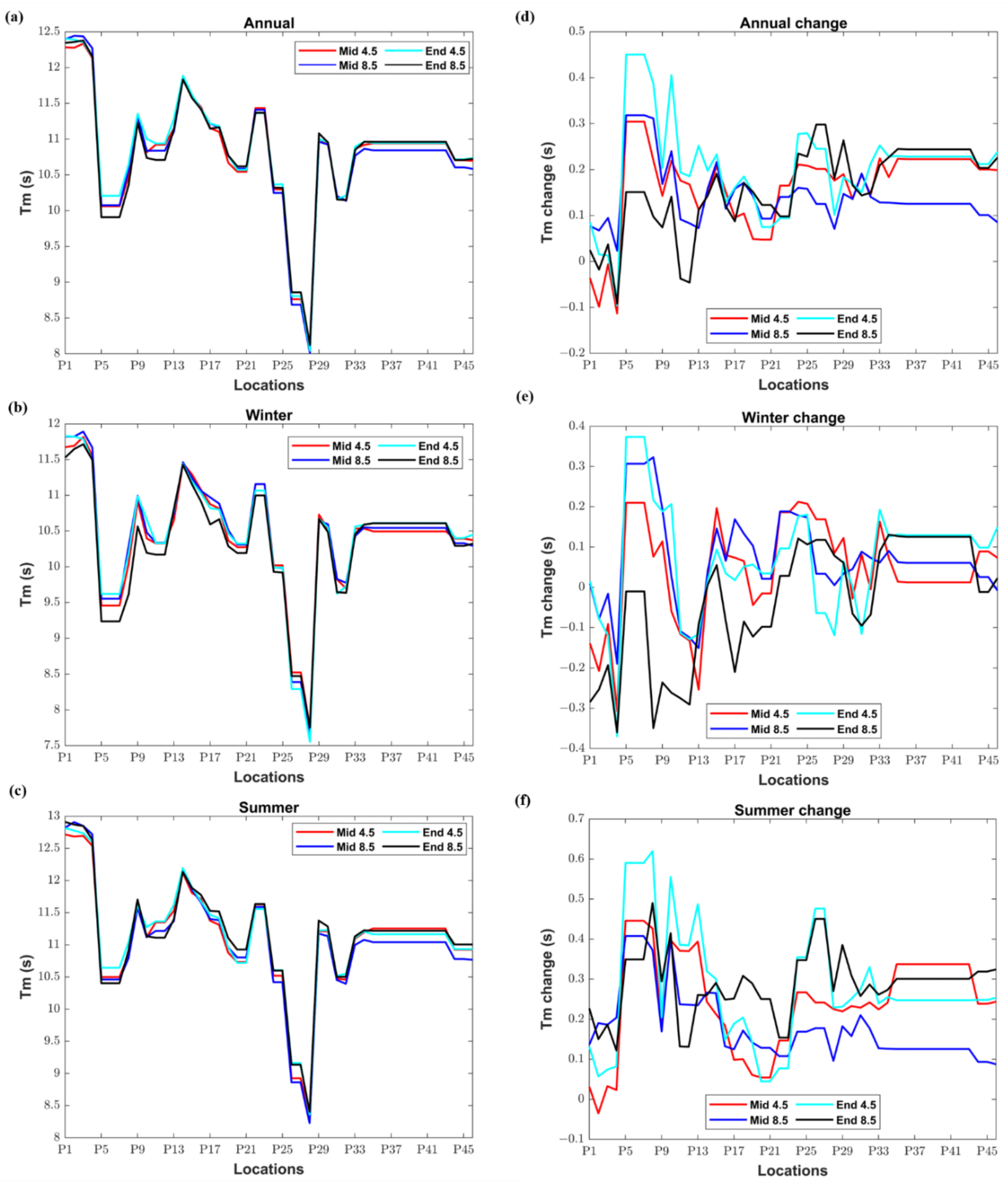
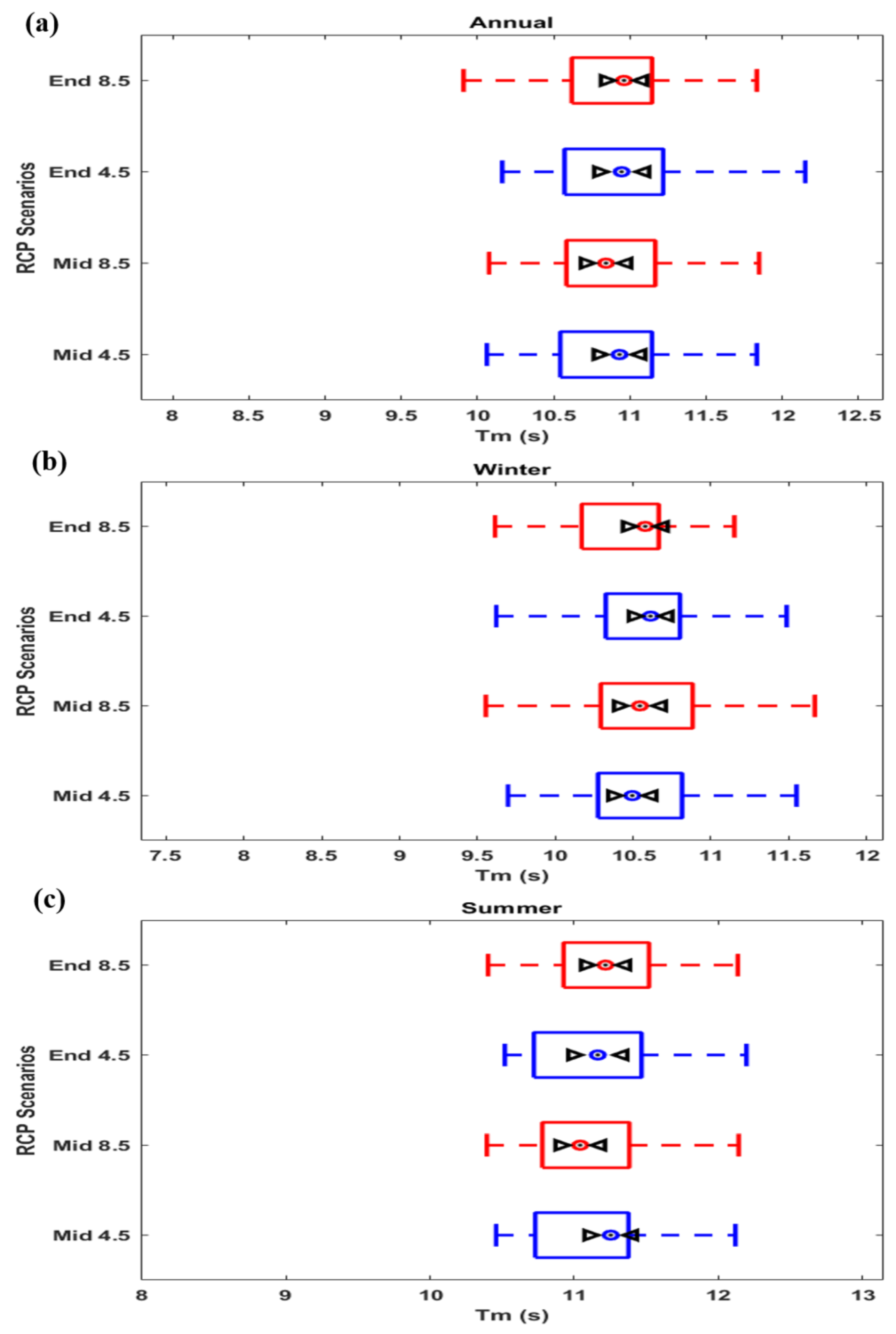

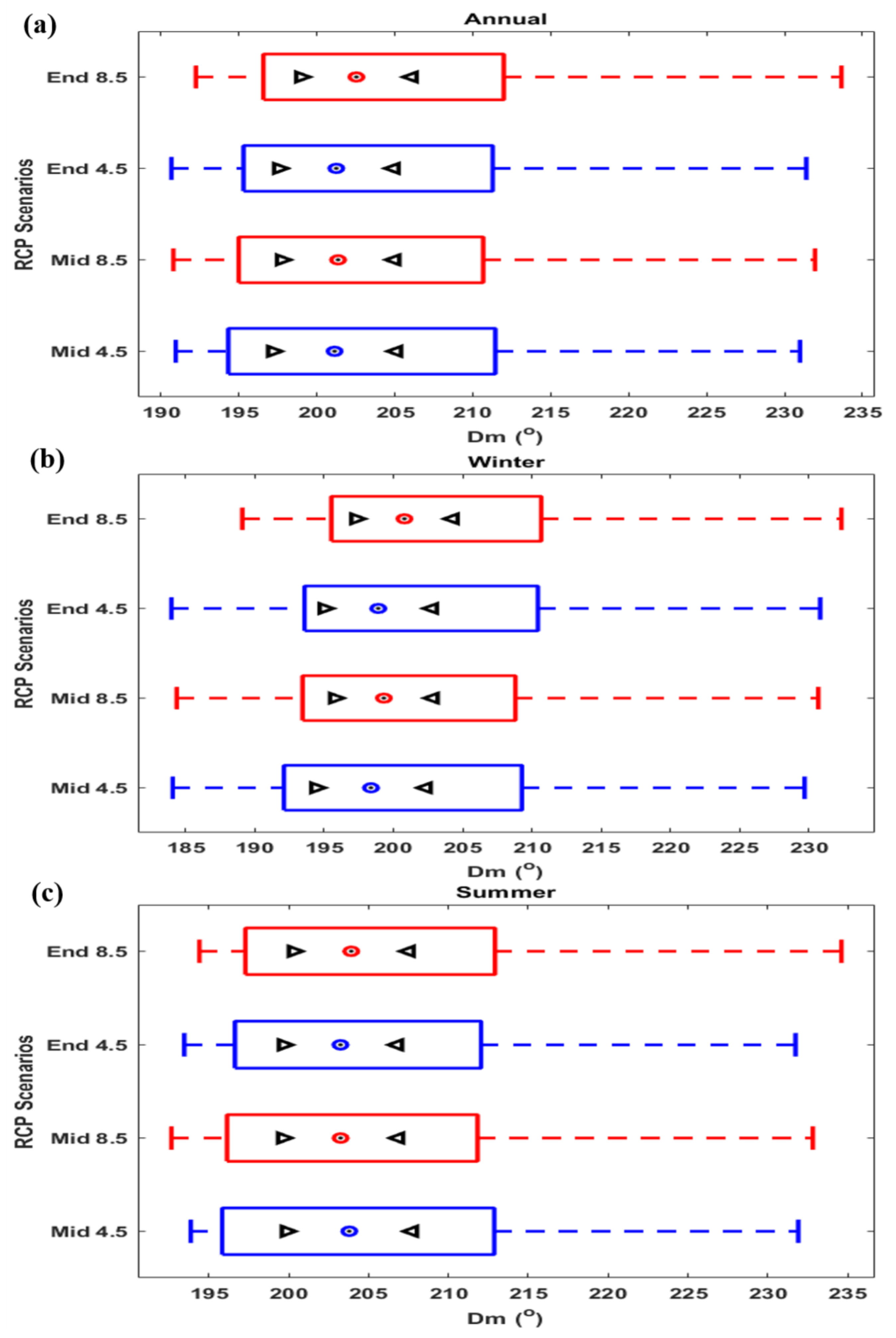
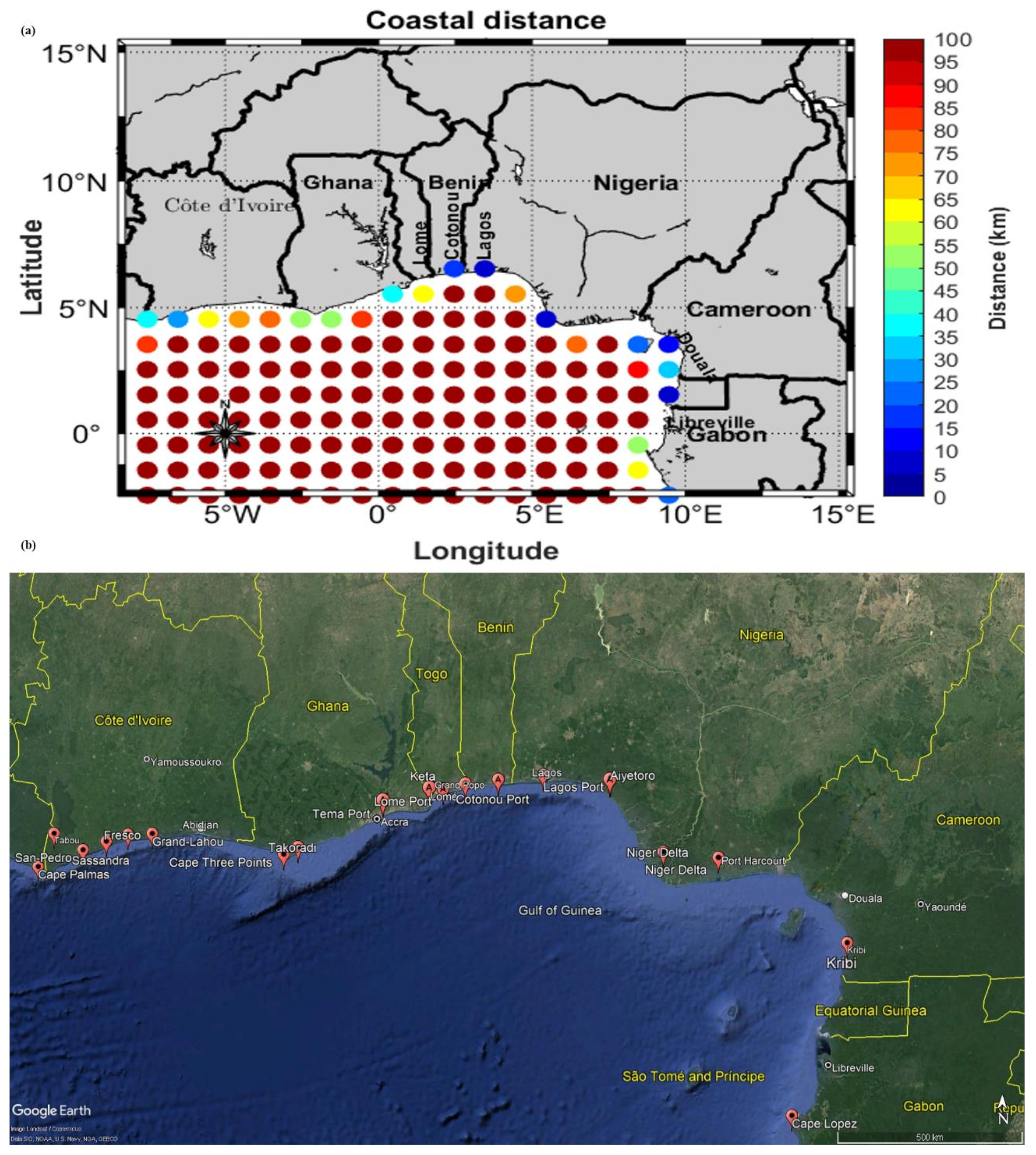
| S/N | GCM | Model Full Name |
|---|---|---|
| 1 | ACCESS1.0 | Australian Community Climate and Earth System Simulator 1.0 |
| 2 | BCC-CSM1.1 | Beijing Climate Centre, Climate System Model, 1-1 |
| 3 | CNRM-CM5 | Centre National de Recherches Meteorologiques Coupled Global Climate Model, version 5 |
| 4 | GFDL-CM3 | Geophysical Fluid Dynamics Laboratory Climate Model 3 |
| 5 | HadGEM2-ES | Hadley Centre Global Environmental Model 2, Earth System |
| 6 | INM-CM4 | Institute of Numerical Mathematics Coupled Model, version 4.0 |
| 7 | MIROC5 | Model for Interdisciplinary Research on Climate, version 5 |
| 8 | MRI-CGCM3 | Meteorological Research Institute Coupled Atmosphere-Ocean General Circulation Model, version 3 |
| Wave Climate | Annual | Winter | Summer |
|---|---|---|---|
| Extreme Hs (m) | 1.47 | 1.26 | 1.62 |
| Extreme Hs trend (m per year) | 1.4 × 10−3 | 6.3 × 10−3 | −2.1 × 10−3 |
| Wave Climate | Annual | Winter | Summer |
|---|---|---|---|
| Extreme Tm (s) | 10.65 | 10.37 | 10.86 |
| Extreme Tm trend (s per year) | 9.7 × 10−3 | 18.7 × 10−3 | 7.3 × 10−3 |
| Wave Climate | Annual | Winter | Summer |
|---|---|---|---|
| Extreme Dm (°) | 204.39 | 201.89 | 206.27 |
| Extreme Dm trend (° per year) | −29.2 × 10−3 | −12.6 × 10−3 | −6.7 × 10−3 |
| Time Slice | RCP Scenario | Annual Average (m) | Annual Change (m) | Winter Average (m) | Winter Change (m) | Summer Average (m) | Summer Change (m) |
|---|---|---|---|---|---|---|---|
| Mid century (2026–2045) | RCP 4.5 | 1.49 | 0.017 | 1.24 | −0.026 | 1.67 | 0.048 |
| RCP 8.5 | 1.50 | 0.027 | 1.25 | −0.0083 | 1.67 | 0.052 | |
| End century (2081–2100) | RCP 4.5 | 1.50 | 0.026 | 1.24 | −0.023 | 1.68 | 0.061 |
| RCP 8.5 | 1.53 | 0.056 | 1.26 | −0.0049 | 1.72 | 0.10 |
| Period | F-Value | p-Value |
|---|---|---|
| Annual | 0.0729 | 0.9744 |
| Winter | 0.0392 | 0.9896 |
| Summer | 0.1191 | 0.9488 |
| Time Slice | RCP Scenario | Annual Average (s) | Annual Change (s) | Winter Average (s) | Winter Change (s) | Summer Average (s) | Summer Change (s) |
|---|---|---|---|---|---|---|---|
| Mid-century (2026–2045) | RCP 4.5 | 10.81 | 0.16 | 10.41 | 0.040 | 11.10 | 0.24 |
| RCP 8.5 | 10.79 | 0.14 | 10.44 | 0.071 | 11.04 | 0.18 | |
| End-century (2081–2100) | RCP 4.5 | 10.86 | 0.21 | 10.49 | 0.071 | 11.14 | 0.28 |
| RCP 8.5 | 10.81 | 0.16 | 10.34 | −0.032 | 11.15 | 0.29 |
| Period | F-Value | p-Value |
|---|---|---|
| Annual | 0.0472 | 0.9863 |
| Winter | 0.1617 | 0.9220 |
| Summer | 0.1410 | 0.9353 |
| Time Slice | RCP Scenario | Annual Average (°) | Annual Change (°) | Winter Average (°) | Winter Change (°) | Summer Average (°) | Summer Change (°) |
|---|---|---|---|---|---|---|---|
| Mid-century (2026–2045) | RCP 4.5 | 204.88 | 0.48 | 202.20 | 0.31 | 206.74 | 0.47 |
| RCP 8.5 | 204.93 | 0.54 | 202.50 | 0.61 | 206.63 | 0.35 | |
| End-century (2081–2100) | RCP 4.5 | 205.09 | 0.69 | 202.81 | 0.92 | 206.75 | 0.48 |
| RCP 8.5 | 206.58 | 2.19 | 204.80 | 2.92 | 207.78 | 1.51 |
| Period | F-Value | p-Value |
|---|---|---|
| Annual | 0.2149 | 0.8860 |
| Winter | 0.3954 | 0.7564 |
| Summer | 0.1029 | 0.9583 |
| Time Slice | Past (1979–2005) | Mid-Century (2026–2045) | End Century (2081–2100) | ||
|---|---|---|---|---|---|
| RCP Scenario | RCP 4.5 (°) | RCP 8.5 (°) | RCP 4.5 (°) | RCP 8.5 (°) | |
| Cape Palmas–San Pedro (P44–P46) | 195.3–198.8 | 193.0–199.5 | 195.6–199.2 | 195.9–199.5 | 197.6–200.4 |
| San Pedro to Takoradi (P35–P43) | 192.8–195.8 | 192.1–195.8 | 193.4–196.1 | 193.6–196.6 | 195.5–197.3 |
| Togo–Benin (P25–P29) | 180.4–199.2 | 192.9–201.6 | 193.8–201.5 | 193.2–200.4 | 195.9–201.3 |
| Western Nigeria (P18–P21) | 205.6–213.6 | 207.3–212.9 | 208.8–214.1 | 211.4–214.3 | 211.3–214.8 |
| Eastern Nigeria (P13–P17) | 206.3–217−7 | 214.6–217.0 | 213.7–217.1 | 214.6–217.3 | 215.3–218.9 |
| Cameroon–E. Guinea (P5–P9) | 232.0–233.2 | 229.7–231.9 | 230.7–232.8 | 230.8–231.7 | 232.4–234.6 |
| Gabon (P1–P4) | 205.1–207.9 | 207.4–208.8 | 207.0–207.1 | 207.7–208.9 | 207.7–209.8 |
Publisher’s Note: MDPI stays neutral with regard to jurisdictional claims in published maps and institutional affiliations. |
© 2022 by the authors. Licensee MDPI, Basel, Switzerland. This article is an open access article distributed under the terms and conditions of the Creative Commons Attribution (CC BY) license (https://creativecommons.org/licenses/by/4.0/).
Share and Cite
Dahunsi, A.M.; Bonou, F.; Dada, O.A.; Baloïtcha, E. Spatio-Temporal Trend of Past and Future Extreme Wave Climates in the Gulf of Guinea Driven by Climate Change. J. Mar. Sci. Eng. 2022, 10, 1581. https://doi.org/10.3390/jmse10111581
Dahunsi AM, Bonou F, Dada OA, Baloïtcha E. Spatio-Temporal Trend of Past and Future Extreme Wave Climates in the Gulf of Guinea Driven by Climate Change. Journal of Marine Science and Engineering. 2022; 10(11):1581. https://doi.org/10.3390/jmse10111581
Chicago/Turabian StyleDahunsi, Adeola M., Frédéric Bonou, Olusegun A. Dada, and Ezinvi Baloïtcha. 2022. "Spatio-Temporal Trend of Past and Future Extreme Wave Climates in the Gulf of Guinea Driven by Climate Change" Journal of Marine Science and Engineering 10, no. 11: 1581. https://doi.org/10.3390/jmse10111581
APA StyleDahunsi, A. M., Bonou, F., Dada, O. A., & Baloïtcha, E. (2022). Spatio-Temporal Trend of Past and Future Extreme Wave Climates in the Gulf of Guinea Driven by Climate Change. Journal of Marine Science and Engineering, 10(11), 1581. https://doi.org/10.3390/jmse10111581






